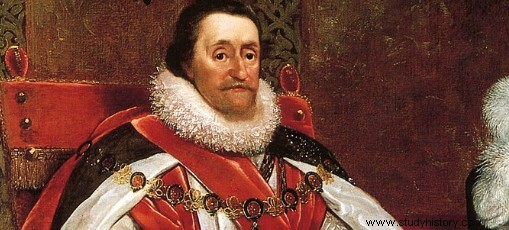Queen Elizabeth died without marriage for the rest of her life. Therefore, the Tudor dynasty was cut off here, and King James VI of Scotland, who is in the lineage of Henry VII, the founder of the Tudor dynasty, was newly appointed as King James I of England.
England and Scotland appear to be the same country when viewed as "England", but they were annexed in the first half of the 17th century, when they were still different countries.
Therefore, at this time, it is still correct to call it England-Scottish Personal Union (Personal Union) instead of "England".
The king named Elizabeth I and killed her mother

In 1566, James I was born to Sir Henry Stewart and Queen of Scotland Mary Stewart.
He was born the successor to the Scottish throne and was named by Elizabeth I.
However, Queen Elizabeth and Queen Mary began to fight each other, and Queen Elizabeth eventually executed Mary Stewart for being involved in her attempted assassination.
The execution of Mary, a Catholic, stimulated the Pope and Spain, and shortly thereafter Spain sent the Armada fleet to England and the Armada War broke out between the two countries.
Her result was an English victory, and surprisingly Queen Elizabeth nominated Mary's son, James I, as her own successor.
Henry VIII, the father of Queen Elizabeth, stipulated the Act of Settlement of the Throne, which stipulated that children of the Stewart family could not become King of England, but with the strong support of Queen Elizabeth, James I became King of England. It was accepted without any resistance.
James I was a fairly scholarly man, published a book entitled "The True Law of the Free Kingdom," and was an advocate of the Divine Right of Kings.
Many lawmakers were worried about this, but when James I showed his stance of adhering to England's traditional "foundation law (a policy that emphasizes parliament)," Congress welcomed James I and actually became Queen Elizabeth. I had a meeting for a comparable period.
Religious issues
The impact of "religious reform" on European history was enormous. In England, the Anglican Church has been created in opposition to the Pope since Henry VIII, and her child, Queen Elizabeth, has cracked down on Catholics.
James I, who succeeded the throne of Scotland and England at the same time, faced a difficult problem in this regard.
Within James I, there was a vision to unite England, Wales, Scotland and Ireland into one country, the perfect union, and the desire to unify language, law, parliament and religion.
However, in reality, there are considerable difficulties, and it can be said that even as of 2019, it has not been realized in the end. Centralization of English and Scottish parliaments and religions was virtually impossible.
James I addressed this issue by "separating" it. Basically, England ruled the Anglican Church and Parliament, and Scotland, in a similar way, ruled both countries side by side.
However, there was a backlash from Catholics in England. They were still cracked down during the time of Queen Elizabeth, so there were high expectations for James I.
James I basically took over the line of Queen Elizabeth and suppressed Catholicism, which led to the "Gunpowder Plot" in which Catholics tried to bomb James I.
Waste King
It is often the case today that academically successful people lack a sense of finance, but James I was one of the representatives.
The amount of debt he and his family have saved was huge at 600,000 pounds, and James I, who was in trouble, instead of abolishing some feudal taxes, called the "Great Contract" at 200,000 pounds each year. I tried to get a subsidy in the parliament, but this did not pass, and instead I made a baronet position called Baronet between Baron and Knight and sold it to make a profit.
Around this time, a gap was formed between Congress and James I, and James I became a hard-line stance not to hold Congress for six years after 1614.
James I reopened the parliament to deal with the Thirty Years War in Germany. Elizabeth, daughter of James I, was the wife of Frederick V, the Electoral Palatinate of the Holy Roman Empire, and was in the midst of the Thirty Years' War.
James I opened a parliament to save his daughter, but there was no warfare due to the waste of the James I family in the first place.
There, James I tries to marry his son to a Spanish princess, but he also faces a fierce opposition from Congress, which is hostile to Spain.
James I himself set out to reconcile with Spain, such as revoking his privateer license to pirates, but this was also uninteresting for Congress.
James I died in 1625 in the midst of such an unsuccessful blockade. He was 58 years old.
